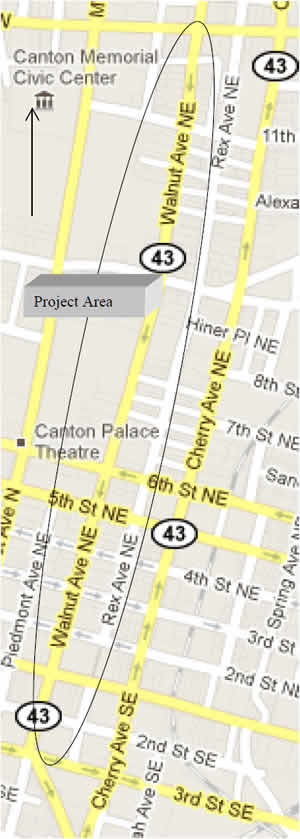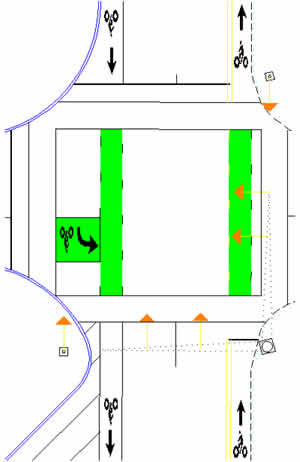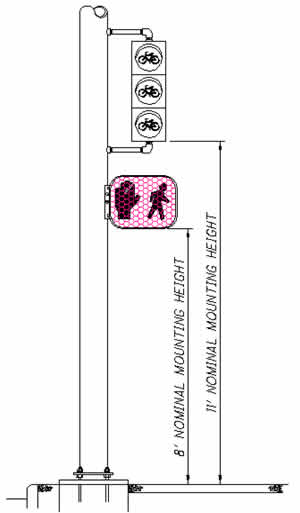 |
PDF Version, 88KB
PDF files can be viewed with the Acrobat® Reader®.
The City of Canton, Ohio is submitting the attached request for permission to experiment with the installation of bicycle signal heads. Their use will be evaluated for improving the safety of a project that will convert a one way vehicular roadway into a roadway with one way vehicular traffic and two way bicycle traffic by the use of a contraflow bicycle lane. This project is intended to enhance bicycle facilities in the City of Canton and promote the use of alternate modes of transportation. The city buses have added bike racks to the buses and several new bus shelters will be installed along Walnut Avenue. This project is a major step towards creating an extensive bicycle network in the Canton area. Various standard elements will be employed to provide safe travel for all users, including signage to denote bike only lanes and to prohibit turns from cross streets. Striping and pavement markings will also be used to convey the appropriate use for all lanes.
Due to the unique nature of this project and the change from a one way to a two way street (bike traffic only) it is our desire to investigate all means of protecting the cycling and motoring public. All parking will be eliminated on the east side of Walnut Avenue and back-in diagonal parking will be added to the west side of Walnut Avenue. Back-in diagonal parking has been found to be safer for bicyclists compared to parallel or head-first parking. Elimination of the parking on the east side of Walnut Avenue will eliminate conflicts with northbound bicyclists and open car doors. This type of collision is common where parking is allowed adjacent to bike lanes.
Also, two-stage turn-queue boxes will be added at each intersection for bicycles to safely make a left-hand turn by riding straight through the green light along Walnut Avenue and waiting in the green box for the light to turn green on the cross street. The two-stage turn-queue boxes are intended to prevent bicyclists from crossing over two lanes of traffic on the southbound direction of Walnut Avenue when making a left-hand turn. Similarly, they are intended to prevent northbound bicyclists from crossing over into oncoming traffic on Walnut Avenue when they make a left-hand turn. The configuration of an intersection with a two-stage turn-queue box is illustrated in Figure 2. The position of the boxes places the bicycles in front of vehicular traffic and allows them safely to proceed down the intersecting streets when the traffic light permits. In order to eliminate confusion regarding the newly marked northbound bicycle lane it is our desire to install bicycle signal heads as a part of this project.
The attached application includes the elements prescribed under Section 1A.10 of the Manual on Uniform Traffic Control Devices for Streets and Highways (MUTCD). Hammontree & Associates, Limited will assist the City in evaluating the effectiveness of the experimental signals and two-stage turn-queue boxes.
Figure 1. Walnut Avenue Corridor

Walnut Avenue from 12th Street NE to3rd Street SE is currently a one way southbound road with three marked lanes of vehicular travel. Plans are being developed to convert this roadway to accommodate two southbound lanes of vehicular traffic, one southbound lane for bicyclists, and a contraflow northbound lane for bicyclists. The contraflow northbound bicycle lane will be separated from southbound traffic with a solid double yellow center line. The northbound contraflow bike lane will end at 12th Street. Bicyclists will be instructed with proper signage to alert them of the change in traffic lane configuration. Signage will be installed to alert vehicles travelling on Walnut Avenue that the bike lanes begin at 12th Street. Bike lane symbols will be installed in both the north and south bound bicycle lanes. All turns on red will be prohibited from the cross streets and signs will be installed to alert vehicles of two way bike traffic on Walnut Avenue.
At each signalized intersection new signal heads will be installed for the contraflow bicycle lane. Vehicles crossing Walnut Avenue may be confused by the double yellow center line and proposed south facing signals. Motorists may focus on the signal instead of the proposed signage and assume that vehicular traffic is permitted in that direction.
In order to avoid possible vehicular confusion and promote bicycle safety it is proposed to install bicycle signal heads for the northbound contraflow bicycle lane and the southbound bicycle lane. This will reinforce the signage and let users know that only bicycles should be travelling north on this section of Walnut Avenue.
The bicycle signal heads are not currently in the MUTCD. The deviation is only in the depiction of the bike symbol on the signal heads. The colors of the light and the placement of the signals will be in accordance with the MUTCD.
Bicycles signal heads are expected to be am improvement over current standards for the northbound bike traffic because it clearly alerts all road users that the signal is only intended for bicycles.
Some type of south-facing signal is required for the northbound bicycle traffic to inform them of when they are allowed to proceed. Since bicycles are the only vehicle type allowed to travel north on Walnut Avenue, a signal that has bike symbols is much more appropriate than a normal vehicular signal. If a normal vehicular signal was used for the northbound bicycle traffic, then vehicles approaching Walnut Avenue from side streets may see the signal and think Walnut is a two-way street for motor vehicles.
A north-facing bike signal would promote bicycle safety, especially for southbound bicycles proceeding through an intersection that may cross the path of a southbound vehicle turning right at the intersection. If bicycles and vehicles both use the vehicular signal head, there is a potentially dangerous conflict, especially when the light turns yellow. If a bicycle is very close to the intersection and heading straight through when the light turns yellow, the bicyclist will continue because they have time to clear the intersection before the all red interval. A right-turning vehicle that is farther back may see the light turn yellow and speed up to avoid waiting at a red light. The driver's attention will be focused on beating the red light and not on the bicyclist, which would ultimately lead to a right hook collision. With a bicycle signal head, bicycles would see phasing similar to pedestrian head phasing. The vehicular head would turn yellow after the bicycle head turns red, which is a much safer option.
A figure of the proposed intersection configurations is shown below along with the signal head pole mounting detail and an image of a bicycle signal head.

Figure 2. Intersection detail

Figure 3. Bike signal mounting detail (not to scale)

Figure 4. Bike signal head
Bicycle signal heads are in use in many cities in the United States including New York City, NY, Portland OR and Davis, CA. Where used the bicycle signal heads have been determined to be easy to understand by bicyclists and motorists. The bicycle traffic signal is an approved traffic control device in the State of California. They are also used in various foreign countries such as Great Britain and Germany.
They are also used in various foreign countries such as Great Britain and Germany.
The devices proposed for use are not protected by patent or copyright.
The following timeline and steps are proposed to monitor the effectiveness of the experimentation.
October 2011, a public meeting was held in the City of Canton and the project was well received by those in attendance.
April 2012, prior to installation-Place article in local newspaper explaining the bicycle signal heads. Education efforts will be coordinated with the Stark County Park District.
May 2012,-collect data to establish before conditions. June/July 2012-Install bicycle signal heads as part of the project to place a contraflow bike lane on Walnut Avenue.
August 2012, one month after installation-Collect traffic and accident data for Walnut Avenue from 12th Street NW to 2nd Street SW.
October 2012, three months after installation-Collect traffic and accident data for Walnut Avenue from 12th Street NW to 2nd Street SW.
December 2012, - Submit interim report to FHWA.
March 2013, nine months after installation-Collect traffic and accident data for Walnut Avenue from 12th Street NW to 2nd Street SW.
June 2013, twelve months after installation-Collect traffic and accident data for Walnut Avenue from 12th Street NW to 2nd Street SW.
Fall 2013, submit final report to FHWA.
Winter 2013, Bicycle signal heads will be left in place permanently or removed.
Bicycle signals will be installed indefinitely at the following intersections:
9th Street NE and Walnut Avenue
6th Street NE and Walnut Avenue
5th Street NE and Walnut Avenue
4th Street NE and Walnut Avenue
3rd Street NE and Walnut Avenue
2nd Street NE and Walnut Avenue
Tuscarawas Street and Walnut Avenue
2nd Street SE and Walnut Avenue
3rd Street SE and Walnut Avenue
The research and evaluation of the proposed signals will include a count of vehicles, bicyclists and pedestrians at the 9 intersections proposed for this experiment. Information will be collected manually, with tube counters, and with video equipment. This data will be collected on one weekday and one Saturday. Accident data for this section of Walnut Avenue will be obtained.
The experimental signals will be installed along with the other improvements to this transportation corridor. Traffic counts will be obtained at intervals outlined in the preceding schedule. From the before and after installation counts the following factors will likely be evaluated.
Number of vehicles, pedestrians and bicycles
Vehicle compliance with signs, signals, and pavement markings
Bicycle compliance with signs, signals and pavement markings
Conflicts between vehicles and bicycles
Confusion of users
As a part of the research and evaluation, special attention will be given to the effectiveness of the two-stage turn-queue boxes as there are few locations in the United States where this new type of traffic control has been used.
The experimentation will conclude with a report to FHWA. If the report does not show an improvement the regular signal heads will replace the bicycle signal heads.
If at any time if it is determined that the experiment directly or indirectly causes significant safety hazards the experiment will be terminated and MUTCD compliant signal heads will be installed.
Progress reports will be submitted within 30 days from the experimentation schedule listed above. Semiannual progress reports will be submitted and a copy of the final results will be submitted to HOTO within three months of the experiment's end.
|
United States Department of Transportation - Federal Highway Administration |
||